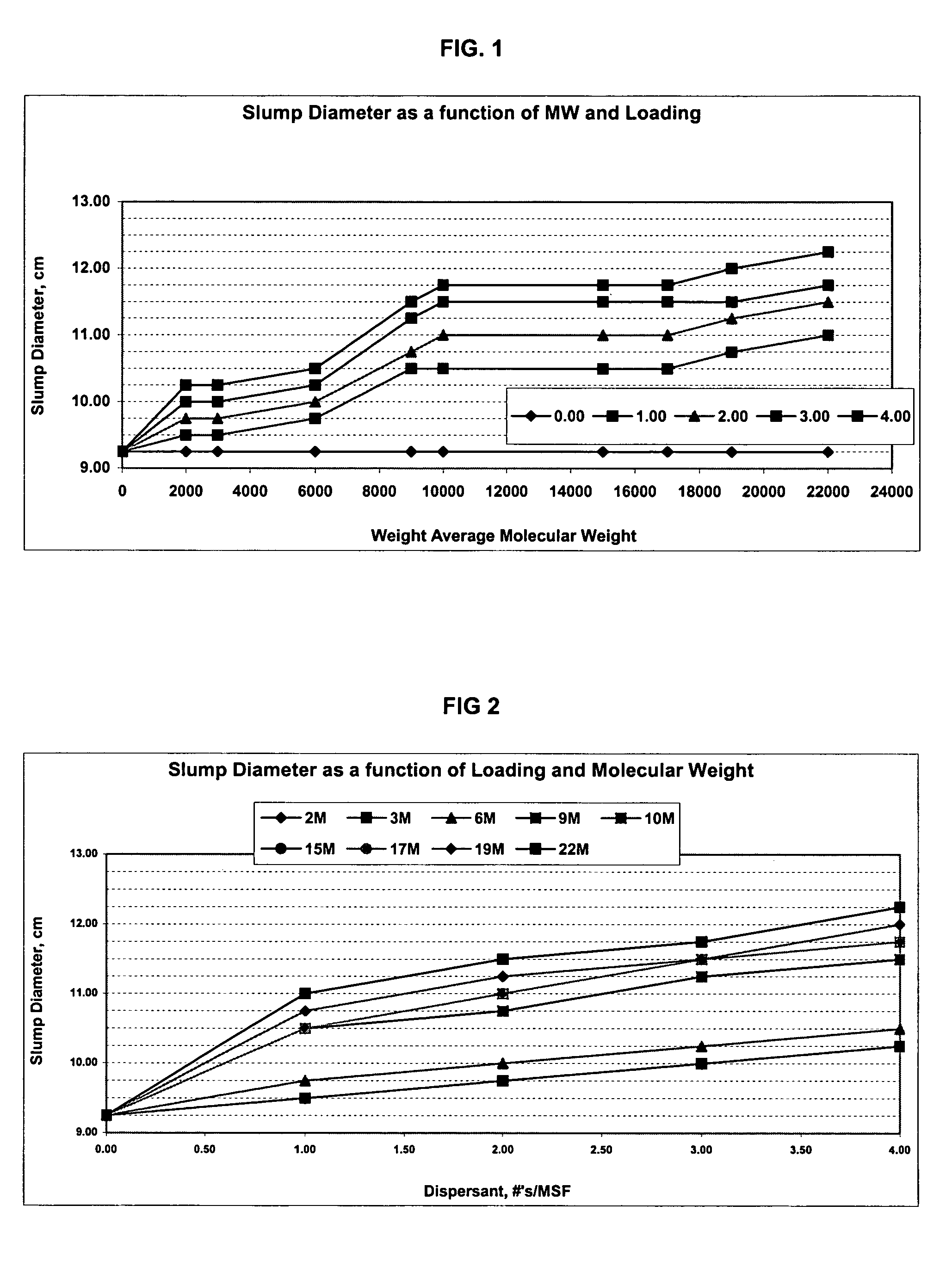Dispersant and foaming agent combination
a foaming agent and dispersant technology, applied in the field of dispersant and foaming agent combination, can solve the problems of increasing the final cost of gypsum wallboard, increasing freight charges, and reducing so as to reduce the density and overall weight of the final product, increase the strength of wallboard, and reduce the amount of water
- Summary
- Abstract
- Description
- Claims
- Application Information
AI Technical Summary
Benefits of technology
Problems solved by technology
Method used
Image
Examples
example 2
[0036] 50 grams of stucco (less any solids derived from the dispersant used) were placed into a mixing cup. 36 grams of water (less any water derived from the dispersant used) were placed into a second mixing cup. Various dosages of the dispersants formed in Example 1 were added to the water in the second mixing cup to approximate the pounds of dispersant that would be present per thousand square feet ("MSF") of dried, finished wallboard if the material had been used to form 1 / 2" gypsum wallboard. The stucco was added into the water / dispersant mixing cup and the components were blended by rapid hand stirring for 30 seconds. Immediately after mixing, the slurry was poured directly onto a clean glass surface from a height of 4 cm. A roughly uniform diameter disc was formed in each case. The discs were allowed to set thoroughly and when completely set (hardened / dried), were removed from the glass surface using a metal spatula. The discs were turned over and their diameters were measure...
example 3
[0038] One-half inch thick gypsum wallboards were produced at a commercial wallboard plant operating at a line speed of 410 feet per minute. The aqueous gypsum slurries used to fabricate the wallboards were sandwiched between sheets of paper weighing 45 pounds per MSF. The aqueous gypsum slurries consisted of mixtures of 1,365 pounds per MSF of calcined gypsum, 10 pounds per MSF of accelerator (ball milled gypsum crystals), 470 pounds per MSF of gauging water, 470 pounds per MSF of raw water, 110 pounds per MSF of foam water, 8.5 pounds per MSF of starch, 0.5 pounds per MSF of fiberglass, 0.18 pounds per MSF of retarder (diethylenetriaminepentaacetic acid), and the loadings in pounds per MSF of dispersant from Example 1) and foaming agent specified in Table 2 below. "AES" is an alkyl ether sulfate foaming agent sold as HYONIC PFM 33, and "AES / AS" is a combination alkyl ether sulfate / alkyl sulfate foaming agent sold as HYONIC PFM 10, both of which are available from GEO Specialty Che...
example 4
[0039] One-half inch thick gypsum wallboards were produced at a commercial wallboard plant operating at a line speed of 410 feet per minute. The aqueous gypsum slurries used to fabricate the wallboards had the same general composition as set forth in Example 3 above (exclusive of dispersants and foaming agents). In Plant Trial 4-A, the aqueous gypsum slurry further comprised 4.0 pounds per MSF of the 22,000 weight average molecular weight dispersant formed in Example 1, but no foaming agent. In Plant Trial 4-B, the aqueous gypsum slurry further comprised 4.0 pounds per MSF of the 22,000 weight average molecular weight dispersant formed in Example 1 and 0.26 pounds per MSF of HYONIC PFM 10 foaming agent. Wallboards were formed by sandwiching the aqueous slurries between sheets of paper weighing 45 pounds per thousand square feet at a rate of 1,670 pounds of aqueous slurry per thousand square feet. The hardened finished wallboards were then tested for nail pull resistance. Wallboard f...
PUM
| Property | Measurement | Unit |
|---|---|---|
| thickness | aaaaa | aaaaa |
| mole ratio | aaaaa | aaaaa |
| mole ratio | aaaaa | aaaaa |
Abstract
Description
Claims
Application Information
 Login to View More
Login to View More - R&D
- Intellectual Property
- Life Sciences
- Materials
- Tech Scout
- Unparalleled Data Quality
- Higher Quality Content
- 60% Fewer Hallucinations
Browse by: Latest US Patents, China's latest patents, Technical Efficacy Thesaurus, Application Domain, Technology Topic, Popular Technical Reports.
© 2025 PatSnap. All rights reserved.Legal|Privacy policy|Modern Slavery Act Transparency Statement|Sitemap|About US| Contact US: help@patsnap.com

